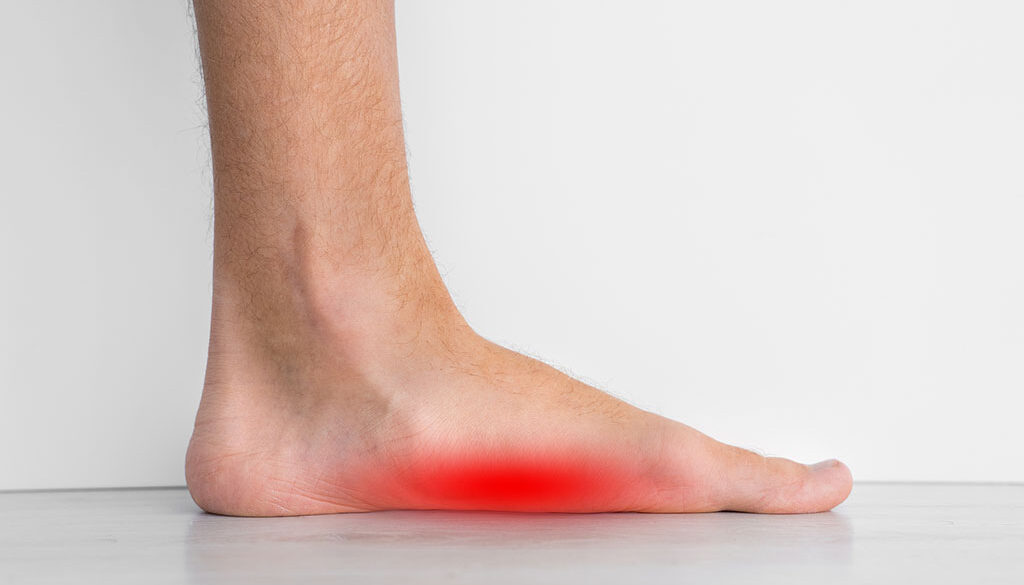How Do I Get Relief From Foot Pain From Flat Feet?
When you have foot pain from flat feet, it can transform your daily living. Mobility issues and difficulty walking can eventually lead to the pain spreading and even radiating into your hip or lower back.
We’ve assisted hundreds of patients in managing and treating fallen arches, commonly known as flat feet. Addressing this condition requires a personalized approach to alleviate pain and effectively manage the ongoing, challenging symptoms it causes.
In this blog, we’ll examine the solutions we provide for flat feet to give you freedom from pain and enhanced mobility.
But first, let’s briefly review this condition.
What Causes Flat Feet?
Flat feet center around a problem with your foot arches. It occurs when the inside of your feet flatten whenever you put pressure on them. If you have flat feet, you’ll notice that the entire sole of your foot touches the floor when you stand.
Flat feet can be caused by:
- Developmental problems with the arches (usually occurring during childhood)
- Injury
- Age– bones tend to weaken with extensive use
What Are the Symptoms of Flat Feet?
As we mentioned earlier, the appearance of a flatted sole can be the prime indicator. A flat foot doesn’t always cause pain, but when it does it can cause swelling and foot fatigue. In some instances, flat feet may not cause any symptoms unless you’ve been running, walking or standing for extended periods of time.
But what about treatment for flat feet, and how can our board-certified orthopedic surgeons in Raleigh help alleviate pain so you can return to the activities you love?
Raleigh Bone and Joint Surgery Clinic: Our Effective Treatments for Flat Feet
Fortunately, surgery for flat feet is only performed if you have extreme pain and nonsurgical treatments have failed. Surgery is typically only considered for severe cases. It may also be an option to repair damage to tendons and ligaments due to flat feet. However, surgical intervention doesn’t always permanently correct flat feet.
We always take a conservative approach to medicine. This means that we always implement nonsurgical solutions first. Some treatments we may suggest include:
Using proper footwear
It may seem obvious, but it’s vital to choose the right shoes for flat feet. Arch support for flat feet is vital. Look for footwear with:
- Arch support
- Adequate cushioning
- Heel support
- A proper fit
- Stability
Not sure where to get started? After all, there are a lot of choices at retail shoe stores across the Triangle, and brands that promise arch support for flat feet. Speak with our physical therapists. They can provide detailed guidance so you know exactly what you need to purchase.
Strengthening and Stretching Exercises
Exercises that focus on the calves, Achilles tendon and the muscles in the feet and legs can alleviate some of the pain and stiffness.
Did you know we have our own in-house physical therapy team?
This is just another way we’ve provided economic efficiency with convenience. Now you don’t have to go to several locations to get the services you need. All of our physical therapists are board-certified through the American Physical Therapy Association.
Short foot exercises
While more research needs to be done on this topic, some studies have indicated that doing these exercises improves your foot posture–even in people with chronic ankle instability. However, these exercises can be challenging to do correctly, and there is still a lot of debate about their overall effectiveness.
Our in-house physical therapy team will provide a personal evaluation to see if short foot exercises —or other types of exercises – may be the most beneficial treatment for flat feet.
Self-care methods
Sometimes warm foot baths and even massages can go a long way toward relief.
Can Flat Feet Be Corrected?

Eliminate the Discomfort From Flat Feet: Contact Us Today
There’s no reason to continue to struggle with the pain and discomfort of flat feet. Our board-certified orthopedic surgeons in Raleigh have served the community for more than 50 years, offering personalized solutions to improve your overall mobility.
With in-house physical therapy and privileges at several outpatient facilities throughout the area, we offer the perfect combination of compassion, state-of-the-art care, and convenience. Contact us for an appointment today.
The content within this article and others on this website is only for educational purposes and should not be considered as medical advice. For any questions or concerns, please consult with your healthcare provider.
===
Sources:
Hara, Shigeyuki, Kitano, Masashi, and Kudo, Shintarou. ‘The Effects of Short Foot Exercises to Treat Flat Foot Deformity: A Systematic Review’. 1 Jan. 2023 : 21 – 33. https://content.iospress.com/articles/journal-of-back-and-musculoskeletal-rehabilitation/bmr210374
Mayo Clinic, “Flat Feet,” https://www.mayoclinic.org/diseases-conditions/flatfeet/symptoms-causes/syc-20372604
New York Presbyterian Hospital, “Flat Feet,” https://www.nyp.org/orthopedics/columbia-orthopedics/flat-feet/treatment#:~:text=Flat%20feet%20can%20be%20corrected,Locations%20%3E
Penn Medicine, “Flat Foot Reconstruction Surgery,” https://www.pennmedicine.org/for-patients-and-visitors/find-a-program-or-service/orthopaedics/foot-and-ankle-pain/flat-foot-and-high-arches-treatment#:~:text=Flat%20Foot%20Reconstruction%20Surgery

